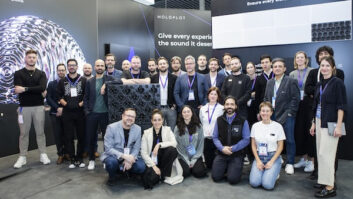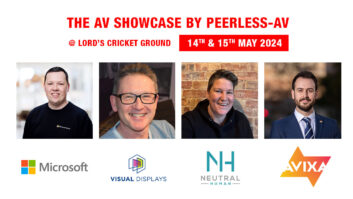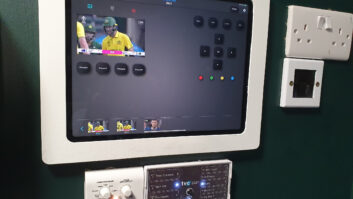
The 15 Years of Excellence Awards goes to a company or organisation that has made a major contribution to the AV installation world, through technology, industry education or leadership.
Installation has decided to present the award to Barco, on account of its continued and consistent innovation in display and other technologies, across numerous markets, throughout this period.
The award will be accepted on the evening by Dirk Hendrickx, Barco’s vice president strategic marketing programs, who has been with the company since before our first edition was published. We spoke to him recently about the past 15 years.
First, let me congratulate Barco on winning the 15 Years of Excellence Award.
Thank you very much. Barco turns 80 this year, and it has been a story of reinvention, renewal and entrepreneurship all that time.
What for you have been the highlights of Barco’s technological achievements over the past 15 years?
The past 15 years have been exciting. As a generic highlight, I think we were one of the first companies that could call themselves an AV manufacturer.
Since 1999, I think we’ve seen the light about the importance of networking. For instance, in our control room business, in 2001 we anticipated that by 2015 the majority of control rooms would be network-centric rather than AV-centric – and that has come true.
As a consequence of that, your abilities and your competencies as a company change drastically. Ten or 15 years ago we were talking about RGB and all the different AV specifications for how to carry a signal over an expensive wire. Today we are there – not only for control rooms but also in corporate AV, in surgical rooms, in bedside terminals. So we’re helping to move the industry towards a network which, 99% of the time, is already there – which is the corporate IT network. I think that’s one of the not so visible, but very obvious, changes that this company has made.
Moving forward, network-centric visualisation, if you can call it that, is going to play not only an eminent, but a dominant role.
That, presumably, is behind the strategy to move beyond display products into networking products such as Clickshare. Were there earlier manifestations of that strategy?
There were earlier manifestations of Clickshare, in fact. We first thought it as a concept in 2005 or 2006, and it went through many iterations.
When we see issues inside markets that we work in, we take a step back, look at the issue and try to find a solution for it. The forerunner of Clickshare was the XDS-100, which we launched in 2008. We mimicked Microsoft XP – as well as My Pictures and My Documents you could add My Sources – but it was a little too complex for the average person to use. Not every bright solution gets it right first time.
Does Barco ever go in the opposite direction, following the technology, without a practical application in mind to start with?
If you were to challenge me to come up with an example where technology was the only thing that brought a certain solution, I think I would have to dig deep. We have a huge number of very clever and knowledgeable engineers, which puts us in the position of understanding a market need and relating it to a potential technological solution. That’s what I believe is beautiful about Barco – there is only a short line between marketing, what is happening out there, and what can be done on a technological basis. One of our advantages, even without our products, is that we have 4,500 employees, and most people stay for their whole career, so we generate a lot of knowledge inside the company that is hard to beat.
Barco has made a number of acquisitions over the years – including projectiondesign last year and, most recently, X2O Media. What is the company’s acquisition strategy?
There are two things. We try to find technology which fits our strategy and increases our competencies in that market. And we also look to buy market share – for instance when we acquired FIMI, Philips’ medical display division, in 2009. Last year, projectiondesign was an extension in our knowledge of single-chip DLP and was also about market share in corporate AV and simulation.
If you look at other acquisitions such as IPVS [streaming high-density data and recording], AWIND [wireless communication] and recently X2O Media, these are technical acquisitions in domains where we see demand to solve issues in the future – they are very specific competencies that we didn’t have previously. With X2O, we’ve bought ourselves to an extent into HTML5 and into signage applications and – this is the next big step, I think – grabbing data and making graphics out if it.
Do you have any predictions for the next few years?
We believe that within 10 years, AV equipment will be seen as IT equipment. Ten years ago, hanging multiple projectors on a ceiling required very specific AV knowledge – throw distance, brightness, what kind of screen and so on. When you move to LCD or rear-projection cubes, that competence becomes much smaller. The competence will lie in how you distribute the signals, make them available and make sure that, next to videoconferencing, people can share the data that they’re discussing. There’s nothing more frustrating than having the perfect HD videoconference but not being able to work with the data in a logical and easy way.
So what would your advice be to AV installers in the light of that?
It’s great to have AV knowledge, but make sure all your new hires are Cisco-approved engineers who have an in-depth knowledge of IT – because that’s the way to go.
An IP network will allow you to share anything, anywhere in an easy way. It’s out there inside each corporation – and you can make use of it by putting a transport layer of AV on top of it. If you compare that with installing an in-campus network based on the old AV approach you’ll always lose the battle on cost. And if you then want to break out of that campus into other directions, doing that with an AV-centric solution will be a big hurdle.
IP networks are vulnerable to hackers, so once they have the IP knowledge I would advise them to find out how to deal with security levels within AV over IP networks. That’s going to be the next big thing. We see it happening now: for instance within healthcare and aviation, they have very strict rules. Over the coming years we may see the same standards popping up in the video over IP domain. The information security battle hasn’t been fought, but it is coming.
To find out who is on the shortlist for the Project awards, click here.
Early-bird tickets are currently available for the black tie event to be held on 12 June at the Hilton London Wembley. Book your tickets now!







